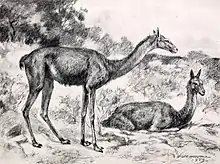Oxydactylus
Oxydactylus is an extinct genus of camelid endemic to North America. It lived from the Late Oligocene to the Middle Miocene (28.4–13.7 mya), existing for approximately 14 million years .[1] The name is from the Ancient Greek οξύς (oxys, "sharp")and δάκτυλος (daktylos, "finger").

O. longipes restoration
| Oxydactylus | |
|---|---|
 | |
| Skeleton of Oxydactylus longipes in the Field Museum of Natural History, Chicago | |
| Scientific classification | |
| Kingdom: | Animalia |
| Phylum: | Chordata |
| Class: | Mammalia |
| Order: | Artiodactyla |
| Family: | Camelidae |
| Tribe: | Camelini |
| Genus: | †Oxydactylus Peterson 1904 |
| Type species | |
| Oxydactylus longipes | |
| Species | |
| |
They had very long legs and necks, and were probably adapted to eating high vegetation, much like modern giraffes. Unlike modern camelids, they had hooves, rather than tough sole-pads, and splayed toes.[2]
References
- Oxydactylus at fosilworks
- Palmer, D., ed. (1999). The Marshall Illustrated Encyclopedia of Dinosaurs and Prehistoric Animals. London: Marshall Editions. p. 277. ISBN 1-84028-152-9.
This article is issued from Wikipedia. The text is licensed under Creative Commons - Attribution - Sharealike. Additional terms may apply for the media files.
